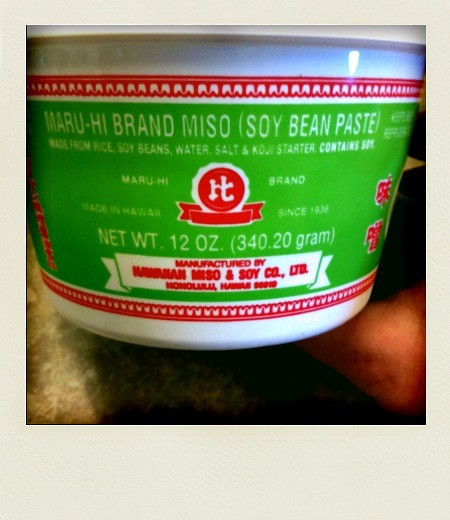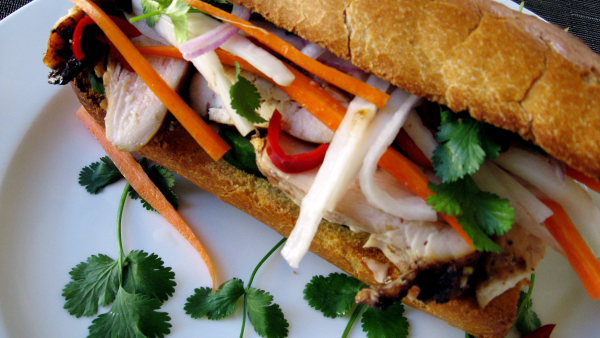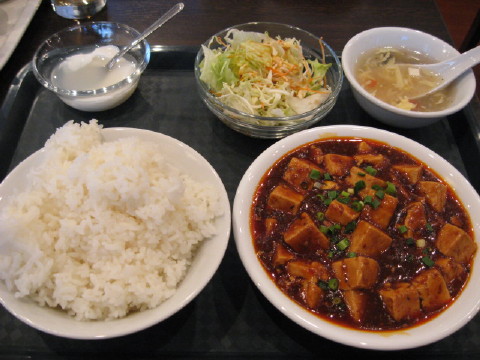
Tofu is coagulated soy bean milk pressed into blocks; it is sometimes
referred to as soy bean curd. In East and Southeast Asia it is a common
food, where although associated with vegetarian Buddhist monks and
nuns, the vast majority of omnivorous populations eat it as as a
"normal" food. In fact tofu dishes are often flavored by small amounts
of animal products such as bits of pork or fish stock (animal proteins
were traditionally a luxury and the modest inhabitants of the non-West
are often bemused by Westerners who can afford to eat them but choose
not to do so); it is - by the way - difficult to be a strict vegetarian
in urban (East and Southeast) Asia, especially if one eats out at all.
Tofu is sometimes called something like meat from the
fields because it has long been recognized as a source of high quality
protein. In fact, soy products are some of the very few vegetarian/vegan/vegetable sources of the
complete set of essential amino acids that we all need. Some say it is
flavorless and it is indeed not strong in that department, but it does
in fact have a subtle flavor. Nonetheless, it also takes on the flavors
one adds to it rather well, absorbing seasonings, sauces, broths, etc.,
well. It is very versatile, and thus fun to cook with. It is almost
impossible to overcook, which is conversely very possible with most
animal sources of protein.
Of particular note is that
tofu comes in a variety of textures, densities, or levels of hardness.
In the US - where one can purchase packaged tofu in most supermarkets -
there is generally soft, firm, and extra firm. For most cooking
applications, firm and extra firm are most appropriate. Soft is good
for salads and eating uncooked with some kind of sauce. People use it
blended to make sauces, deserts, etc.

(Note:
Tofu is available in the La Crosse area at Woodman's, the Co-op, Hmong
supermarkets, and
Festival. However, the tofu at Festival is
inappropriately and oddly EXPENSIVE. West Coast Guy [WCG] suspects this
is because whoever makes such decisions for Festival unwisely
categorizes tofu as "health food," and thus associates it with the
generally higher income people who have the luxury to buy items
categorized in that way. The long and short of it is that unless one
has "money to burn," it is better to buy tofu elsewhere.)
 |
| Hiyakko Tofu |
 |
| Kimchi Tofu |
There are innumerable ways to cook/prepare tofu, and WCG has tried many
of them. Examples common in Japan that don't require cooking include
kimchi tofu, which is Korean style pickled cabbage and other vegetables on top of cold soft tofu, and
hiyakko tofu, which is soft tofu usually topped with
katsuo (dried bonito fish) shavings,
shoyū (soy sauce), and green onions, etc.
If one is hungry and wants a simple tasty protein-heavy dish, WCG
recommends slicing up some soft tofu and pouring on some sauce: soy,
sriracha, tabasco, flavored vinegar, whatever. (
Ponzu sauce works exceptionally well - available at Woodman's in a bottle) One can add green
onions, tomatoes, pickles, etc., too. This tastes good with rice or
alone.
Common cooked tofu dishes in East Asia include Mápó
dòufu, a Sichuan (Szechuan) Chinese dish that is very popular in
Japan, where it is called mābō dōfu. This is a spicy dish that usually
includes chiles, garlic, minced pork, and soy bean paste. Another dish
in Japanese is called buta dōfu, which simply means pork tofu. WCG's
mom used to make this as an every day dish.
The
most common way WCG cooks tofu is in a pan or skillet. This generally
means a kind of stir fry, cooking the tofu with onions, carrots, garlic,
and or other vegetables, along with a mixture of seasonings balancing
salty, spicy, sweet, and perhaps sour flavors.
Recently,
WCG's culinary experiments have led to the realization that cooking the
f&#^ out of tofu leads to good results. Again, it is almost
impossible to overcook the stuff, and when browned to the point of
almost blackening, the tofu undergoes
caramelization, the maillard reaction,
or something like that. The end result is that it tastes good.
Another method WCG has been experimenting with is marinating the tofu
for hours before cooking it. The marinade can consist of a variety of
ingredients, but the WCG goal is to achieve - again - something of a
balance of flavors including at least salty and sweet, and often spicy
plus sour.
 |
| Ikeda Kikunae |
Actually, WCG's goal with savory cooking is to achieve or find what in Japanese is called
umami, but that is the subject of another post. Suffice it to say that this culinary certain something (
je ne sais quoi) taste comes through "cheating" with MSG or some MSG containing substance such as Japanese
Hon Dashi (and MSG was invented by Japanese scientist
Ikeda Kikunae in 1908 to essentially bottle umami), or one can get it from substances such
as, for example, miso and fish sauce. WCG has also noticed that umami
comes from slow cooking vegetables in a pot until their juices flow. A little salt and pepper facilitates this, and for some reason this works much better in a high-sided pot than in a pan. WCG also
suspects that something like umami results from the proper balance of
flavors such as salty, sweet, spicy, and sour, which is the the essence
of, for example,
good Thai cuisine.
 |
| Hawaiian miso |
Pictured below is a
tofu dish WCG made a couple months ago. It features big tofu slabs (the
packaged block sliced once down the middle) marinated overnight in a
mixture of Hawaiian Miso and Canadian maple syrup. WCG
also threw in some Mexican chipoltle powder and some
Vietnamese fish sauce. WCG fried the slabs in fresh Wisconsin butter
from the "Norwegian" town of Westby
and then made a sandwich with the
pan-fried tofu, fresh baby spinach, tomato, sliced onions, and his
homemade Greek yogurt-based sauce as a condiment.
 | | |
Frying tofu in pan (note extra WI butter on top)
|
 |
| Open faced tofu sandwich (and man, it was good!) |
PS: Another great tofu dish is Japanese
age dashi dōfu, which is soft tofu coated with corn or potato starch and fried, and then served in a broth of dashi (generally katsuo/bonito fish stock) flavored with a little mirin (sweet cooking wine) and maybe some shoyū. It is then topped with daikon oroshi, which is daikon grated into a sort of paste, along with green onions, katsuoboshi (shavings of dried bonito fish), and/or grated horseradish.
  |
| Agedashi dōfu and daikon oroshi on its own |
 |
| Daikon |
Daikon is a giant white Japanese radish, which is available in La Crosse supermarkets/grocery stores. Its name literally means "Big root" 大根. As such, if one buys it it inconveniently takes up much space in the fridge. However, WCG recently discovered Hmong farmers selling small daikon at local farmers' markets, but being about the size of carrots, they are somewhat of a misnomer (maybe "small root" or shōkon 小根? I suppose there's words for the small kind in Southeast Asian languages...). They taste like daikon though.

 Besides in banh mi, West Coast Guy (WCG) likes namasu /do chua with rice, and to eat it with some kind of meat or fish (see tilapia recipe below). But it is great on toast or crackers with some cheese, for example chèvre (goat cheese). Whenever I make these veggies (using local small, Hmong farmer versions of daikon so far), and share them with others (non-Japanese, non-Vietnamese), they eat a lot of it.... It is very good.
Besides in banh mi, West Coast Guy (WCG) likes namasu /do chua with rice, and to eat it with some kind of meat or fish (see tilapia recipe below). But it is great on toast or crackers with some cheese, for example chèvre (goat cheese). Whenever I make these veggies (using local small, Hmong farmer versions of daikon so far), and share them with others (non-Japanese, non-Vietnamese), they eat a lot of it.... It is very good.











